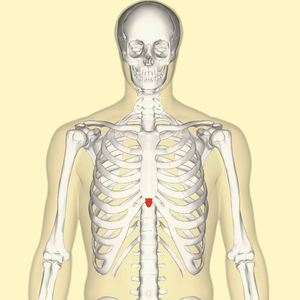Xiphodynia
| Xiphodynia | |
|---|---|
| Other names: Painful xiphoid syndrome, xiphoid syndrome, xiphoidalgia | |
 | |
| Position of the xiphoid process (shown in red). | |
| Symptoms | Pain around the xiphoid process when touched[1] |
| Causes | Generally unknown[2] |
| Risk factors | Injury to the area[3] |
| Diagnostic method | Based on symptoms after ruling out other possible causes[3] |
| Differential diagnosis | GERD, stomach ulcers, gallstones, heart disease[3] |
| Treatment | Simple pain medication, corticosteroids injections, surgical removal[1][3] |
| Prognosis | Typically gets better with time[1] |
| Frequency | Rare[3] |
Xiphodynia is a condition that results in pain around the xiphoid process when it is touched.[1] Pain may be referred to other parts of the chest, abdomen, or arms.[3] It may be worsened by bending forwards or excessive eating.[3] Occasionally nausea or vomiting may be present.[4]
The cause is generally unknown, though it have been reported after injury to the area.[2][3] The underlying mechanism may involve osteoarthritis or inflammatory arthritis of the xiphisternal joint.[3] Diagnosis is generally based on reoccurrence of the pain with pushing on the xiphoid after other potential causes are ruled out.[3] Other conditions that may present similarly include GERD, stomach ulcers, gallstones, and heart disease.[3]
Treatment is generally with simple pain medication.[1] Rarely injections of corticosteroids or surgical removal may be used.[1][3] Often it gets better over weeks to months.[1][2]
Xiphodynia is rare.[3] The condition was initially described in 1712.[5] The term is from the Greek work "xiphos" which means sword and "odyne" which means pain.[5][6]
Signs and symptoms
Symptoms may include:[7]
- Chest pain
- Abdominal pain
- Nausea, vomiting, and diarrhoea
- Radiating pain into the back, neck, shoulders, arms and chest wall[8]
References
- ↑ 1.0 1.1 1.2 1.3 1.4 1.5 1.6 Mott, T; Jones, G; Roman, K (1 July 2021). "Costochondritis: Rapid Evidence Review". American family physician. 104 (1): 73–78. PMID 34264599.
- ↑ 2.0 2.1 2.2 Dolin, Simon J.; Padfield, Nicholas L. (2004). Pain Medicine Manual. Butterworth-Heinemann. p. 116. ISBN 978-0-7506-5617-7. Archived from the original on 2023-02-01. Retrieved 2023-01-31.
- ↑ 3.00 3.01 3.02 3.03 3.04 3.05 3.06 3.07 3.08 3.09 3.10 3.11 3.12 Noor, N; Amgalan, A; Vij, N; Habib, K; Anantuni, L; An, D; Kassem, H; Paladini, A; Varrassi, G; Kaye, AD (2022). "Treatment and Management of Xiphoidalgia". Orthopedic reviews. 14 (3): 37070. doi:10.52965/001c.37070. PMID 36034722.
- ↑ Goodman, Catherine C.; Heick, John; Lazaro, Rolando T. (29 April 2017). Differential Diagnosis for Physical Therapists- E-Book. Elsevier Health Sciences. p. 667. ISBN 978-0-323-47848-9. Archived from the original on 1 February 2023. Retrieved 31 January 2023.
- ↑ 5.0 5.1 Migliore, M; Signorelli, M (25 April 2012). "Episodic abdominal and chest pain in a young adult". JAMA. 307 (16): 1746–7. doi:10.1001/jama.2012.506. PMID 22535859.
- ↑ "xiphoid | Etymology, origin and meaning of xiphoid by etymonline". www.etymonline.com. Archived from the original on 15 June 2022. Retrieved 31 January 2023.
- ↑ Simpson, J. Keith; Hawken, Erin (2007). "Xiphodynia: A diagnostic conundrum". Chiropractic & Osteopathy. 15 (1): 13. doi:10.1186/1746-1340-15-13. PMC 2045657. PMID 17868466.
- ↑ Howell, John M. (July 1992). "Xiphodynia: A report of three cases". The Journal of Emergency Medicine. 10 (4): 435–438. doi:10.1016/0736-4679(92)90272-U.